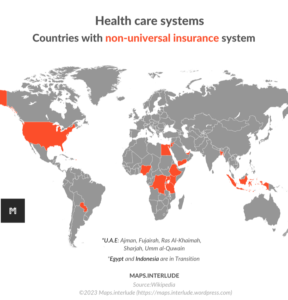The killing of UnitedHealthcare’s CEO Brian Thompson by alleged gunman Luigi Mangione focused the spotlight on the inequality of healthcare in the U.S. As the American news broadcasting legend Walter Cronkite once said, “America’s health care system is neither healthy, caring nor a system.” Let’s take a few minutes to examine healthcare in the U.S. versus the rest of the world.
 To put the American healthcare system into perspective, it is best to start with the hard truth. The U.S. is the only country in the industrialized world without universal healthcare. The. Only. One. The map helps put this shocking reality into perspective. While the U.S. is amongst the richest countries in the world, its health system is not even in the top ten.
To put the American healthcare system into perspective, it is best to start with the hard truth. The U.S. is the only country in the industrialized world without universal healthcare. The. Only. One. The map helps put this shocking reality into perspective. While the U.S. is amongst the richest countries in the world, its health system is not even in the top ten.
This doesn’t mean that the U.S. lacks a medical-industrial complex. The country has an expansive multibillion-dollar enterprise consisting of doctors, hospitals, nursing homes, insurance companies, drug manufacturers, and hospital supply and equipment companies. The U.S. spends $14, 570 per person or $4.9 trillion on health care. This is thousands of dollars more than spent in other countries around the world. According to the U.S. Census Bureau, 92 percent of people have health insurance. Of that, 65 percent have private insurance, and 36 percent have public insurance. On the surface, these numbers sound good. The issue is that the U.S. system does not provide enough coverage at an affordable price.
Is this because Americans are that much sicker than people in other countries? That doesn’t make sense. Why would a country with a thriving medical industrial complex have sicker citizens? If we set aside a discussion on how the American food industry negatively impacts health, that leads us to consider other things that affect healthcare, namely the cost of medications and treatments. Consider these costs in the various industrialized nations:
Childbirth — Standard delivery
| U.S. | France | Germany | Spain | U.K. |
| $10,808 | $2,360 | $2,157 | $1,950 | $4,609 |
Heart Bypass Surgery
| U.S. | Australia | Switzerland | Spain | Netherlands |
| $75,345 | $42,130 | $36,509 | $16,000 | $15,742 |
Prescriptions — Spending Per Capita
| U.S. | France | Germany | U.K. | Sweden |
| $1,011 | $553 | $686 | 497 | $351 |
*All prices are in U.S. dollars.
In European nations, the government plays a key role in regulating or capping prices to maintain affordability for citizens. In the U.S., pharmaceutical manufacturers and insurance companies negotiate prices. The result is that when you go to pick up a prescription, the price might be $135 for you, but only $35 for the person standing next to you because you have different insurance companies that negotiate radically different out-of-pocket prices. And the person without insurance? That poor soul is paying the full price of $500 for the same prescription. In fact, insurance companies and pharmacies have been accused of overcharging American patients by as much as 1000 percent.
It is worth mentioning that beginning in 2026, the Inflation Reduction Act of 2022 was supposed to allow the U.S. government to negotiate certain drug prices for citizens on Medicare, a government program established in 1965 funding healthcare for people over 65, people with disabilities, and people receiving long-term treatment with dialysis. While the scope of this act was limited, 62 percent of Americans polled were in favor of the federal government playing a role in the negotiation of drug prices. Through executive orders, President Trump overturned the Inflation Reduction Act of 2022 on January 20, 2025.
Prices aside, whether medical treatment is approved in the U.S. is often out of the hands of humans. Historically, a patient with an issue would see their doctor who would recommend a course of action and alert or petition the insurance company before being approved for treatment by insurance company employees. Increasingly, American insurance companies are now using artificial intelligence (AI) to determine who can and cannot receive treatment. Seemingly, the goal of this technology is to save money. The problem is that in some instances the AI algorithm has been accused of rejecting requests for treatment that doctors deem medically necessary. UnitedHealth is facing a lawsuit over its use of AI for this very reason. Additionally, there is concern that AI may not be providing accurate information. Known as “AI hallucination,” it is the frightening fact that sometimes the AI tools used in hospitals make things up and put random notes in people’s medical records. Europe has taken steps to address the role of AI in medicine by introducing the EU AI Act in March 2024. The American Food and Drug Administration (FDA) introduced some regulations back in 1995 when AI was first introduced, but nothing substantive exists on the federal level. To combat the slow response of the U.S. government to this issue, increasingly, U.S. states are introducing their own laws to deal with AI in healthcare.
 The wild west nature of the American medical system is best understood by considering a 2024 tweet from “X” owner Elon Musk. To help educate his AI platform “Grok,” Musk asked users of his social media platform to “Try submitting x-ray, PET, MRI or other medical images to Grok for analysis…” That Grok isn’t ready for primetime was highlighted by the fact that it mistook a breast cyst for testicles and tuberculosis for a herniated disk. In addition to posting medical records on “X” being a frightening violation of federal patient privacy laws, this stunt highlighted why universal health care matters. Without government protection and parameters, healthcare in a capitalist system values profit over people… every time.
The wild west nature of the American medical system is best understood by considering a 2024 tweet from “X” owner Elon Musk. To help educate his AI platform “Grok,” Musk asked users of his social media platform to “Try submitting x-ray, PET, MRI or other medical images to Grok for analysis…” That Grok isn’t ready for primetime was highlighted by the fact that it mistook a breast cyst for testicles and tuberculosis for a herniated disk. In addition to posting medical records on “X” being a frightening violation of federal patient privacy laws, this stunt highlighted why universal health care matters. Without government protection and parameters, healthcare in a capitalist system values profit over people… every time.
Thompson is a co-owner of UITAC Publishing. UITAC’s mission is to provide high-quality, affordable, and socially responsible online course materials.
Images used in this blog:
- “Woman Looking at a Microscope” by Edward Jenner is licensed on Pexels. This image has not been altered.
- “Countries with non-universal insurance systems” by Maps.interlude is licensed under CC BY-SA 4.0. The image has not been altered.
- “Elon Musk Brazil 2022“ by Ministério Das Comunicações is licensed under CC BY 2.0. The image has not been altered.




